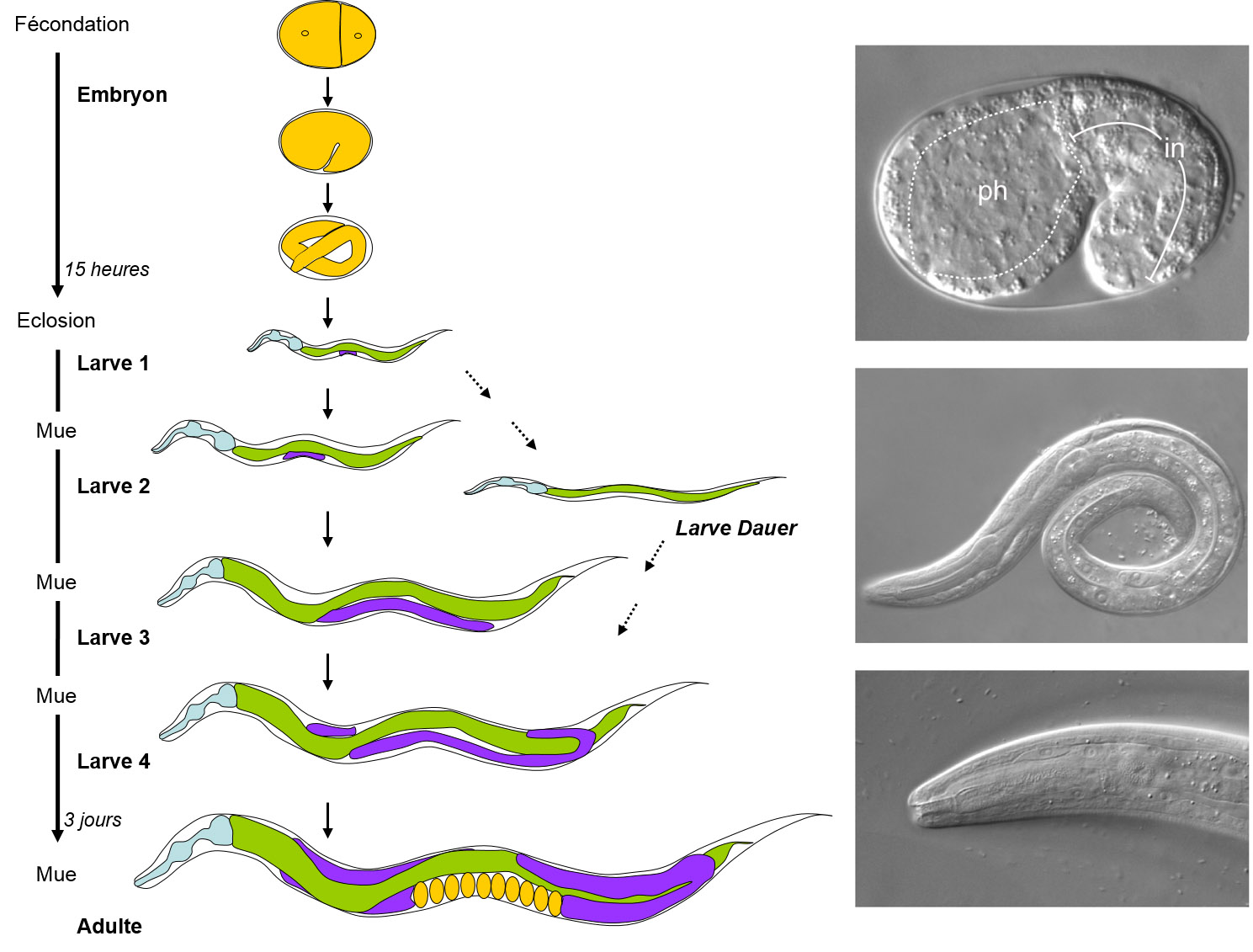Autophagy and Development
Institut de Biologie intégrative de la cellule (I2BC)CNRS- bat. 26
Avenue de La Terrasse
91198 GIF sur Yvette Cedex
France - Gif sur Yvette
Site web - renaud.legouis@cgm.cnrs-gif.fr -
Principal investigator
Renaud Legouis

Research themes
Recent studies have highlighted the large variety of physiological and pathophysiological roles of autophagy such as developmental process, cell death, aging, antigen presentation, elimination of microorganisms and tumour suppression. Autophagy has been previously mainly studied in yeast or in cell culture but the use of animal models allows to investigate its role by in vivo and in toto experimental approaches.
The nematode Caenorhabditis elegans offers the possibility to analyze the autophagic process in several different physiological conditions: during development and senescence in response to various stress conditions. Numerous reports describe the presence of increased levels of autophagy for various diseases, however its role could be either protective or deleterious. For these reasons, it is essential to generate models to analyze autophagy on a whole organism both in physiological and pathological conditions. We contributed to demonstrate that Caenorhabditis elegans is a good model to analyze the autophagic process in several different developmental processes and we have characterized the relationships between autophagosomes and endosomes. Since the autophagic pathway is highly conserved in metazoans, data obtained in C. elegans could be essential to understand the role of autophagy in humans. By using in vivo/in toto genetic approaches in a model animal, our objective is to better understand the roles of autophagy during development, differentiation and disease.
Using a large panel of techniques and in particular genetics, biochemistry, and cell biology,we have shown that autophagy is essential for multiple developmental and physiological processes in C. elegans.
Our recent results can be summarized in four points.
-There is a common compartment between endosomes and autophagosomes in C. elegans. Autophagy has a protective role on endosomal dysfunctions in C. elegans.
– Autophagy specifically degrades paternal mitochondria after fertilization (Allophagy).
– Inactivation of “ubiquitin-like” autophagosomal proteins LGG-1 and LGG-2, homologs of Atg8/LC3, synergistically affects the development and longevity.
– LGG-1 and LGG-2 have sequential roles during selective autophagy of paternal mitochondria
Descriptive figure


Publications
– Zhang H, Chang JT, Guo B, Hansen M, Jia K, Kovács AL, Kumsta C, Lapierre LR, Legouis R, Lin L, Lu Q, Meléndez A, O’Rourke EJ, Sato K, Sato M, Wang X, Wu F. Guidelines for monitoring autophagy in Caenorhabditis elegans. Autophagy. 2015 [Epub ahead of print].
– Jenzer C, Simionato E, Legouis R. Tools and methods to analyze Autophagy in C. elegans Methods. 2015 [Epub ahead of print]).
– Jenzer C, Manil-Ségalen M, Lefebvre C, Largeau C, Glatigny A, Legouis R. Human GABARAP can restore autophagosome biogenesis in a C. elegans lgg-1 mutant. Autophagy. 2014 ; 10(10) : 1868-1872.
– Manil-Ségalen M, Lefebvre C, Jenzer C, Trichet M, Boulogne C, Satiat-Jeunemaitre B, Legouis R. The C. elegans LC3 acts downstream of GABARAP to degrade autophagosomes by interacting with the HOPS subunit VPS39. Dev Cell. 2014 ;28(1):43-55.
– Manil-Ségalen M, Culetto E, Legouis R, Lefebvre C. Interactions between endosomal maturation and autophagy: analysis of ESCRT machinery during Caenorhabditis elegans development. Methods Enzymol. 2014 ;534:93-118.
– Manil-Segalén M, Lefebvre C, Culetto E, Legouis R. Need an ESCRT for autophagosomal maturation? Commun Integr Biol. 2012 ;5(6):566-71.
– Al Rawi S, Louvet-Vallée S, Djeddi A, Sachse M, Culetto E, Hajjar C, Boyd L, Legouis R *, Galy V*. Allophagy: a macroautophagic process degrading spermatozoid-inherited organelles. Autophagy. 2012 ;8(3):421-3. * co-last author
– Djeddi A, Michelet X, Culetto E, Alberti A, Barois N, Legouis R. Induction of autophagy in ESCRT mutants is an adaptive response for cell survival in C. elegans. J Cell Sci. 2012 ;125(Pt 3):685-94.
– Al Rawi S, Louvet-Vallée S, Djeddi A, Sachse M, Culetto E, Hajjar C, Boyd L, Legouis R*, Galy V*. Postfertilization autophagy of sperm organelles prevents paternal mitochondrial DNA transmission. Science. 2011 ;334(6059):1144-7. * co-last author
– Alberti A, Michelet X, Djeddi A, Legouis R. The autophagosomal protein LGG-2 acts synergistically with LGG-1 in dauer formation and longevity in C. elegans. Autophagy. 2010 ;6(5):622-33.
– Michelet X, Djeddi A, Legouis R. Developmental and cellular functions of the ESCRT machinery in pluricellular organisms. Biol Cell. 2010 ;102(3):191-202.
Composition de l'équipe
Emmanuel Culetto ; MC Paris-Sud ; emmanuel.culetto@cgm.cnrs-gif.fr
Céline Jenzer ; Doctorante; celine.jenzer@cgm.cnrs-gif.fr
Céline Largeau ; Assistant Ingénieur ; celine.largeau@cgm.cnrs-gif.fr
Christophe Lefebvre ; MC Paris-Sud ; 01.69.82.31.59 ; christophe.lefebvre@cgm.cnrs-gif.fr
Marion Manil-Segalen; Post doctorante; marion.segalen@cgm.cnrs-gif.fr
Elena Simionato; Post doctorante; elena.simionato@cgm.cnrs-gif.fr
Vincent Scarcelli ; Etudiant Master 2 ; vincent.scarcelli@cgm.cnrs-gif.fr